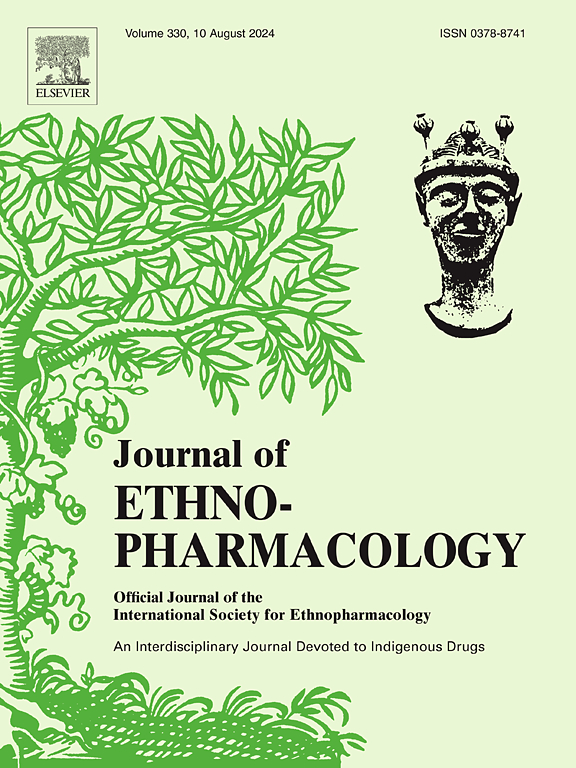基于UPLC/HRMS、网络药理学和实验验证,消瘀明汤通过JAK2/STAT3信号通路增强脑缺血再灌注后的神经保护作用。
IF 4.8
2区 医学
Q1 CHEMISTRY, MEDICINAL
引用次数: 0
摘要
民族药理学相关性:小虚明汤(XXMD)是一种著名的传统中药方剂,具有显著的改善缺血性脑卒中损伤的疗效。研究目的:本研究旨在探讨XXMD对脑缺血再灌注后神经保护的体内外作用及其机制。材料与方法:采用神经行为学实验、TTC染色、HE染色、尼氏染色观察XXMD对大脑中动脉闭塞(MCAO)大鼠脑缺血再灌注损伤的神经保护作用。此外,我们用CCK8和乳酸脱氢酶(LDH)测定来评估细胞活力和损伤。透射电镜(TEM)观察氧-糖剥夺和再氧化(OGD/R)后神经元超微结构的变化。网络分析结合超高效液相色谱-高分辨质谱(UPLC-HRMS)预测XXMD对缺血性脑卒中损伤的作用机制。此外,通过免疫荧光染色和western blot分析,检测神经可塑性相关蛋白neurofilament 200 (NF200)、微管相关蛋白2 (MAP2)、突触后密度蛋白95 (PSD95)、synaptophysin (SYN)、磷酸化Janus激酶2 (p-JAK2)、磷酸化信号转导和转录激活因子3 (p-STAT3)的表达。结果:XXMD显著改善MCAO和再灌注后HT22细胞的行为学、梗死面积和病理改变,减轻OGD/R诱导的HT22细胞形态学和超微结构改变,降低细胞活力。网络药理学结果显示,XXMD有1153个化合物匹配。京都基因与基因组百科全书(KEGG)分析表明,XXMD治疗缺血性脑卒中主要调节炎症反应相关信号通路、动脉粥样硬化相关信号通路。分子对接结果显示,TP53、AKT1、STAT3、IL6与相应的活性成分紧密结合。XXMD治疗显著逆转了上述变化。XXMD或AG490上调了OGD/R后神经可塑性相关蛋白的表达,降低了JAK2、STAT3的磷酸化表达。结论:XXMD通过调控JAK2/STAT3通路促进神经可塑性,发挥神经保护作用,有望成为缺血性脑卒中的替代治疗策略。本文章由计算机程序翻译,如有差异,请以英文原文为准。

Xiaoxuming decoction enhanced neuroprotection after cerebral ischemia/reperfusion via the JAK2/STAT3 signaling pathway based on UPLC/HRMS, network pharmacology and experimental validation
Ethnopharmacological relevance
Xiao-xu-ming decoction (XXMD), a prominent traditional Chinese medicinal formula historically revered for stroke treatment, demonstrates pronounced efficacy in ameliorating ischemic stroke injury.
Aim of the study
This study aims to investigate the effects and mechanisms of XXMD on neuroprotection subsequent to cerebral ischemia/reperfusion in vivo and in vitro.
Materials and methods
Neurobehavioral test, TTC staining, HE staining and nissl staining were used to examine the neuroprotective effect of XXMD on cerebral ischemia-reperfusion injury induced by middle cerebral artery occlusion (MCAO) in rats. Additionally, we assessed cell viability and injury with CCK8 and lactate dehydrogenase (LDH) assays. The changes in neuronal ultra-structure were observed after oxygen-glucose deprivation and reoxygenation (OGD/R) by transmission electron microscopy (TEM). Network analysis combined with ultrahighperformance liquid chromatography-high resolution mass spectrometry (UPLC-HRMS) predicted the mechanism of XXMD on ischemic stroke injury. Furthermore, the expression of neuroplasticity-related proteins neurofilament 200 (NF200), microtubule-associated protein 2 (MAP2), postsynaptic density protein 95 (PSD95), synaptophysin (SYN), phosphorylated Janus kinase2 (p-JAK2), and phosphorylated signal transduction and activator of transcription 3 (p-STAT3) was evaluated by immunofluorescence staining and Western blot analyses.
Results
XXMD significantly improved Ethology, infarct area and pathological changes after MCAO and reperfusion, reducing morphological and ultrastructural alterations and decreased cell viability in HT22 cells induced by OGD/R. Network pharmacology showed that 1153 compounds of XXMD were matched. The Kyoto Encyclopedia of Genes and Genomes (KEGG) analysis demonstrated that XXMD treated ischemia stroke mainly regulating inflammation reaction-related signaling pathways, atherosclerosish-related signaling pathways. Molecular docking results showed that TP53, AKT1, STAT3, and IL6 are closely bound to the corresponding active ingredients. XXMD treatment significantly reversed the above alternations. XXMD or AG490 up-regulated the expression of neuroplasticity-associated proteins, and reduced phosphorylation of JAK2, STAT3 expression following OGD/R.
Conclusion
XXMD exerts neuroprotective effects by promoting neural plasticity via regulating the JAK2/STAT3 pathway, indicating a promising alternative therapeutic strategy for ischemic stroke.
求助全文
通过发布文献求助,成功后即可免费获取论文全文。
去求助
来源期刊

Journal of ethnopharmacology
医学-全科医学与补充医学
CiteScore
10.30
自引率
5.60%
发文量
967
审稿时长
77 days
期刊介绍:
The Journal of Ethnopharmacology is dedicated to the exchange of information and understandings about people''s use of plants, fungi, animals, microorganisms and minerals and their biological and pharmacological effects based on the principles established through international conventions. Early people confronted with illness and disease, discovered a wealth of useful therapeutic agents in the plant and animal kingdoms. The empirical knowledge of these medicinal substances and their toxic potential was passed on by oral tradition and sometimes recorded in herbals and other texts on materia medica. Many valuable drugs of today (e.g., atropine, ephedrine, tubocurarine, digoxin, reserpine) came into use through the study of indigenous remedies. Chemists continue to use plant-derived drugs (e.g., morphine, taxol, physostigmine, quinidine, emetine) as prototypes in their attempts to develop more effective and less toxic medicinals.
 求助内容:
求助内容: 应助结果提醒方式:
应助结果提醒方式:


